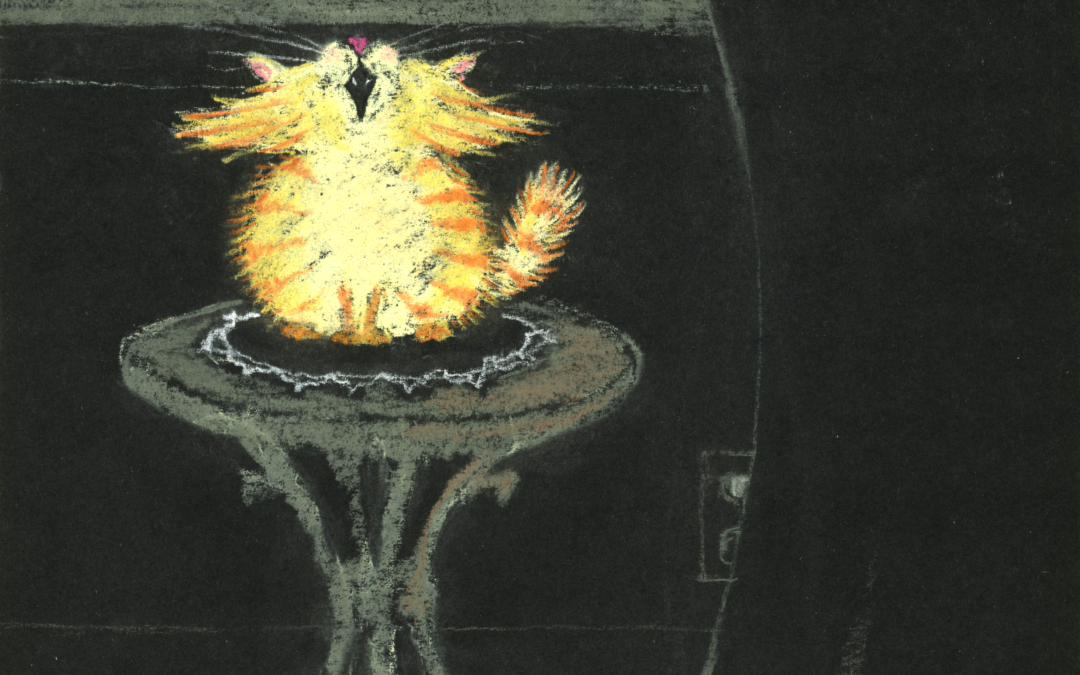
I MEET MAURICE SENDAK
I MEET MAURICE SENDAK
The night of his first lecture, Wheeler Auditorium was bursting—people were squeezed into every corner and mobbed outside the open doors. I didn’t know why it was so jam-packed because I’d never read the copyright date of Where the Wild Things Are—or of any of his other books, for that matter. I didn’t know that these college kids had grown up on his stories.
Ella had even managed to get us invitations to the reception for him afterwards in the Bancroft Library. As we walked over after the lecture, I heard Mr. Sendak behind me, telling his companions how hungry he was.
In the reception room I helped myself to a paper plate of appetizers. As I ate, I noticed that he was advancing toward the buffet table by millimeters only. As soon as he’d finish talking with one person, another would block his path. So I filled a plate with hors d’oeuvres for him and took it over, then stood back and listened to what he had to say to his crowd of admirers. When I was satisfied he wouldn’t bite—and there was a momentary lull—I finally spoke to him.
I told him I’d sent a story around to publishers and kept getting form rejection letters—no personal notes even. I said I thought kids would like it, but had begun to wonder if it was somehow threatening to adults. “Ah!” he said knowingly, “You have to be tricky to get past them.” So I asked him if he’d be willing to read my story and suggest any changes I might make. He graciously said yes.
The afternoon I delivered my manuscript to his hotel, I was a nervous wreck—I’d spent the previous days trying to write a cover letter, and now that he was about to leave, I was afraid I’d miss him altogether. When I handed the manuscript over to the hotel clerk, he gave it to a bellboy to take to Mr. Sendak’s room. I thought there was a remote chance he might read my story that night and call me.
But I never heard from him. Months passed, and I began to wonder if he’d ever received my manuscript—what if the bellboy had taken it to the wrong room? I called the hotel to see if my manila envelope had ended up in some dead-letter bin. Then I wrote reclusive Mr. Sendak himself (how I got his address shall remain my secret). I sent him a postcard with two options for him to check, including “Manuscript? What manuscript?” Which is what he checked.
So I sent him another copy along with a couple of my illustrations, including the one above. More months went by. Figuring he hadn’t liked my story and was too kind-hearted to tell me, I swallowed hard and stopped hoping. Then one December afternoon I arrived home, routinely punched the messages button on my answering machine, and heard an unfamiliar voice through static. I thought it was a wrong number and headed to the fridge. But when I heard the words “twin princes,” I froze in my tracks.
As the static cleared, I heard Mr. Sendak apologizing and explaining that he was just now recovering from a long illness. A few days later a note came on his letterhead for the Sundance Children’s Theater:
Dear Callie Raab,
Just called you—alas, you were not
at home. Beauregard is a wonder! Very well told—
fresh & smart & I do not even mind the happy ending!
If you don’t mind, I will keep this manuscript—
to show to someone in “the business.” Please, have no
hope. I know and trust no one—except this one person.
And I don’t foolishly want to raise your hopes.
Forgive the long delay. A long illness—just—
I hope!—coming out of it.
I return the art—I like them too!
No—I’m not being nice—you are good!
Maurice Sendak
I wrote him back, “When I delivered my manuscript to you at the hotel, I felt I was nearing the end of a long journey. Thank you for making the ending a happy one. Your appreciation of my work is deeply, deeply felt.”
I’d waited half a lifetime for a father’s—or at least a father figure’s—approval, and at long last I had it.

